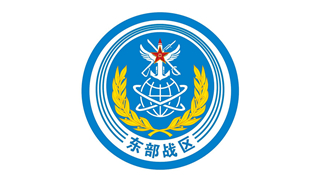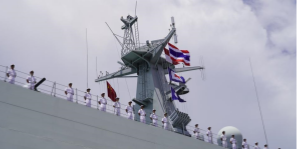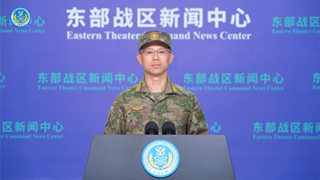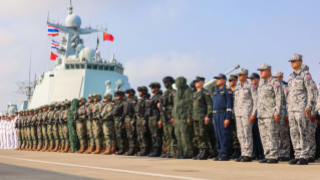By Guo Yilun
郭一伦
On May 27, the Japan Ground Self Defense Force (JGSDF) held its annual large-scale live-fire Fuji Firepower Review. It is reported that unmanned aerial vehicles (UAVs) were first deployed to attack ground targets in this year's exercise, demonstrating the real combat efficiency of AI-assisted UAV operational chains, which can rapidly pinpoint enemy troops, make response solutions according to threat assessment, and give combat instructions based on the intelligence gathered by intelligent analysis and identification of captured images.
5月27日,日本陆上自卫队举行了大规模实弹演习“富士综合火力演习”。据悉,演习首次使用无人机对目标实施对地打击,通过智能分析、识别获取的图像等情报迅速锁定敌军部队,并辅助判断威胁大小、制订应对方案,以及下达作战指令,展示了人工智能(AI)辅助下无人作战链条的实战效用。
Japan issued new versions of the nation's three key security documents at the end of last year, seeking to go beyond the "exclusively defense-oriented" principle within the framework of the pacifist Constitution. It attempts to prioritize the deployment of combat systems consisting of aerial, underwater, and maritime UAVs in its southwestern islands by vigorously developing new technologies such as unmanned equipment, artificial intelligence, new-generation information communication, digital transformation, and high-power energy.
日本去年底出台新版安保三文件,谋求突破基于和平宪法的“专守防卫”原则,企图大力发展“无人装备、人工智能、新一代信息通信、数字转型、高功率能源”等新技术,意欲优先在日本的西南诸岛部署由空中、水下和海上等无人装备构建的作战体系。
In fact, Japan has continuously strengthened the troop deployment in the southwest in recent years, regarding the region as the forefront of the battlefield. The next step of building unmanned combat systems obviously aims at establishing intelligent, seamless, and low-cost forward lookout posts and island blockage networks by resorting to advanced technologies, in a bid to strengthen the construction of new types of combat forces featuring the combination of UAVs and artificial intelligence.
事实上,日本近年来一直在持续加强西南方向的兵力部署,已经将其作为战场最前沿。下一步打造无人作战系统,显然是想要借助先进技术建立起智能、无缝且成本低廉的前方瞭望哨和岛链拦阻网,从而强化“无人+AI”新型战力建设。
Japan's Defense Ministry has planned to expand the application of unmanned combat systems across land, sea, and air, deploying UAV troops in its full-spectrum to JASDF, JMSDF and JGSDF.
日本防卫省已计划将无人作战系统在陆海空全领域扩大运用,航空、海上、陆上自卫队都将新设无人机部队。
In the air domain, the Defense Buildup Program (DBP) proposed to procure utility attack UAVs and miniature attack UAVs that effectively retain various attack functions to enable them to search and identify personnel, vehicles, and naval vessels from the air and quickly strike the targets. In addition to importing offensive drones from Israel or the US, Japan's Defense Ministry will further step up efforts on independent in-house R&D in this field, with a specific goal of possessing hundreds of offensive drones. As to the development plan for the next-generation fighters, Japan has also envisioned the research of unmanned wing planes to conduct cooperative operations between manned aerial vehicles(MAVs) and unmanned aerial vehicles(UAVs). To substantially improve the intelligence reconnaissance and surveillance capabilities over surrounding waters and airspace, Japan has introduced the MQ-9B SeaGuardian UAVs from the US, which have formally been put into actual combat deployment.
在空中,《防卫力量整备计划》提出“配备具有各种攻击能力的多用途攻击无人机和小型攻击无人机,以便能从空中搜索和识别人员、车辆、舰艇等,并迅速实施打击”。防卫省计划从以色列或美国引进攻击型无人机的同时,还将进一步加大国产自主研发力度,使攻击型无人机数量达到数百架。日本在下一代战斗机的开发计划中,也设定了无人僚机的研制构想,将展开有人/无人的协同作战。为大幅提升对周边海空域的情报侦察监视能力,日本从美国引进MQ-9B“海上卫士”无人机,目前已正式展开实战化部署。
In the underwater domain, the unmanned underwater vehicles (UUVs) developed by Japan's Defense Ministry are scheduled to be commissioned by 2025. It is learned that this type of equipment can automatically evade obstacles and detect naval mines and can navigate continually underwater for one week long. Mainly lurking in deep water, these devices can probe submarines and surface vehicles through sonars and automatically track opponent ships with the aid of AI technology. It is worth noting that the Japanese Acquisition, Technology & Logistics Agency (ATLA) is also accelerating the development of models that can lay and clear away naval mines, which can prevent opponents from "attacking its southwestern islands from the sea" and clear the "maritime blockade" by naval mines.
在水下,日本防卫省研制的无人潜航器计划2025年投入使用。据悉,该型装备能自动避开障碍物、探查水雷,可以在水下自主航行长达一周,主要潜伏在深水区,通过声呐探测潜艇和水面舰艇,并借助人工智能技术自动跟踪对手舰艇。值得注意的是,日本防卫装备厅还在加紧研发能布设和扫除水雷的型号,届时可以阻碍对手“从海上进攻西南诸岛”或是扫除对方水雷的“海上封锁”。
In the sea surface domain, Japan is building a new-generation 30FFM multi-role frigate specially built with an unmanned combat system, which can fulfill torpedo search and anti-torpedo tasks by means of unmanned surface ships, unmanned underwater vehicles, and self-propelled anti-torpedo ammunitions onboard. Furthermore, judging from the public bidding performance requirements released by Japan's Defense Ministry, its unmanned patrol boats have a planned displacement of about 1,900 tons and a total length of 90 meters. These kinds of large-size unmanned ships will be able to carry loads with multiple functions.
在海面,日本正在建造的新一代护卫舰——“平成30年度多功能护卫舰”,专门配备了无人作战系统,能搭载无人水面艇、无人潜航器和自航式反水雷弹药等用于执行水雷搜索和反水雷任务。另外,从防卫省对无人巡逻艇公开招标的性能要求来看,其计划排水量在1900吨左右,全长90米,属于较大型的无人舰艇,将可承载多种功能的载荷。
The fact that Japan has been accelerating its unmanned combat capability building and new-type force deployment in the southwest will inevitably stir up the security situation of surrounding regions. This once again proves that Japan has become one of the major factors undermining regional peace and stability, which deserves high vigilance from regional countries.
日本加快推进无人作战能力建设,不断强化西南方向新型战力部署,无疑将搅动周边安全态势。这再一次证明,日本已经成为破坏地区和平稳定的主要因素之一,应该引起地区国家高度警惕。
(The author is from the Air Force Research Institute of the PLA)
(作者单位:空军研究院)









